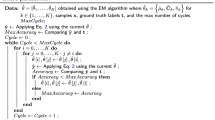Abstract
The traditional Gaussian Mixture Model (GMM) for pattern recognition is an unsupervised learning method. The parameters in the model are derived only by the training samples in one, class without taking into account the effect of sample distributions of other classes, hence, its recognition accuracy is not ideal sometimes. This paper introduces an approach for estimating the parameters in GMM in a supervising way. The Supervised Learning Gaussian Mixture Model (SLGMM) improves the recognition accuracy of the GMM. An experimental example has shown its effectiveness. The experimental results have shown that the recognition accuracy derived by the approach is higher than those obtained by the Vector Quantization (VQ) approach, the Radial Basis Function (RBF) network model, the Learning Vector Quantization (LVQ) approach and the GMM. In addition, the training time of the approach is less than that of Multilayer Perceptron (MLP).
Similar content being viewed by others
Explore related subjects
Discover the latest articles, news and stories from top researchers in related subjects.References
Tuveo Kohonen. Learning vector quantization.Neural Networks, 1988, 1(Suppl.1): 303.
Bishop C M. Neural Networks for Pattern Recognition. Oxford University Press, 1995.
Breiman L, Friedman J H, Olshen R A, Stone C J. Patternification and Regression Trees. Wadsworth International Group, Belmont, CA, 1984.
Aitkin M, Wilson G. Mixture models, outliers, and the EM algorithm.Technometrics, 1980, 22: 325–331.
Hinton G, Revon M, Dayan P. Recognizing handwritten digits using mixtures of linear models. InAdvances in Neural Information Processing Systems 7, Tesauro, Touretzky & Leen (eds.), The MIT Press, Cambridge, Massachusetts, 1995, pp. 1015–1022.
Nandakishore Kambhatla. Local Models and Gaussian Mixture Models for Statistical Data Processing. Ph.D. Dissertation, Dept. of Computer Science and Engineering, Oregon Graduate Institute of Science & Technology, 1996.
Author information
Authors and Affiliations
Additional information
This work was supported by the National Hi-Tech Program of China (863-306-03-01).
Ma Jiyong was born in June 1963. He received the B.S. degree in computational mathematics from Heilongjiang University in 1984 and the M.S. degree in thermal physics from the University of Harbin Architecture and Civil Engineering in 1989. He is a Ph.D. candidate in Computer Science Department of Harbin Institute of Technology. His research interests include pattern recognition, speech recognition, speaker recognition and multimodal information fusion.
Gao Wen was born in 1956. He received the first Ph.D. degree in computer science from Harbin Institute of Technology in 1988, and the second Ph.D. degree in electronics engineering from the University of Tokyo, Japan in 1991. Dr. Gao was a visiting research fellow in the Institute of Medical Electronic Engineering, the University of Tokyo from April 1991 to March 1992, visiting professor in the Robotics Institute, Carnegie Mellon University from July 1993 to November 1993, visiting professor in the MIT Artificial Intelligence Laboratory, from April 1994 to July 1994, and from January 1995 to December 1995. He is an Honorary Professor of City University of Hong Kong. He is the Chairman of Steering Committee for National Hi-Tech Development Programme Intelligent Computing System Subject since 1996. He is the Managing Director of Motorola-NCIC Joint R&D Laboratory for Advanced Computer and Communication Technology, Beijing. Dr. Gao’s research centers on the artificial intelligence, especially on image understanding and intelligent human-computer interface. He has worked on the application of image understanding for many years and has published more than 60 papers and 2 books. He is currently the head of China Delegation for MPEG international standard meeting. He serves as an editorial committee member for a number of leading journals in computer field in China.
Rights and permissions
About this article
Cite this article
Ma, J., Gao, W. The supervised learning Gaussian mixture model. J. of Comput. Sci. & Technol. 13, 471–474 (1998). https://doi.org/10.1007/BF02948506
Received:
Revised:
Issue Date:
DOI: https://doi.org/10.1007/BF02948506




